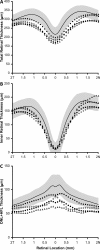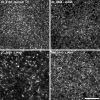Cone Photoreceptor Structure in Patients With X-Linked Cone Dysfunction and Red-Green Color Vision Deficiency
- PMID: 27447086
- PMCID: PMC4968428
- DOI: 10.1167/iovs.16-19608
Cone Photoreceptor Structure in Patients With X-Linked Cone Dysfunction and Red-Green Color Vision Deficiency
Abstract
Purpose: Mutations in the coding sequence of the L and M opsin genes are often associated with X-linked cone dysfunction (such as Bornholm Eye Disease, BED), though the exact color vision phenotype associated with these disorders is variable. We examined individuals with L/M opsin gene mutations to clarify the link between color vision deficiency and cone dysfunction.
Methods: We recruited 17 males for imaging. The thickness and integrity of the photoreceptor layers were evaluated using spectral-domain optical coherence tomography. Cone density was measured using high-resolution images of the cone mosaic obtained with adaptive optics scanning light ophthalmoscopy. The L/M opsin gene array was characterized in 16 subjects, including at least one subject from each family.
Results: There were six subjects with the LVAVA haplotype encoded by exon 3, seven with LIAVA, two with the Cys203Arg mutation encoded by exon 4, and two with a novel insertion in exon 2. Foveal cone structure and retinal thickness was disrupted to a variable degree, even among related individuals with the same L/M array.
Conclusions: Our findings provide a direct link between disruption of the cone mosaic and L/M opsin variants. We hypothesize that, in addition to large phenotypic differences between different L/M opsin variants, the ratio of expression of first versus downstream genes in the L/M array contributes to phenotypic diversity. While the L/M opsin mutations underlie the cone dysfunction in all of the subjects tested, the color vision defect can be caused either by the same mutation or a gene rearrangement at the same locus.
Figures




References
-
- Haim M,, Fledelius HC,, Skarsholm D. X-linked myopia in a Danish family. Acta Ophthalmol. 1988; 66: 450–456. - PubMed
-
- Schwartz M,, Haim M,, Skarsholm D. X-Linked myopia: Bornholm Eye Disease - linkage to DNA markers on the distal part of Xq. Clin Genet. 1990; 38: 281–286. - PubMed
-
- Young TL,, Deeb SS,, Ronan SM,, et al. X-linked high myopia associated with cone dysfunction. Arch Ophthalmol. 2004. ; 122: 897–908. - PubMed
Publication types
MeSH terms
Substances
Grants and funding
LinkOut - more resources
Full Text Sources
Other Literature Sources
Medical

